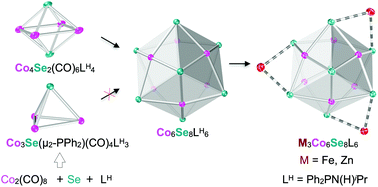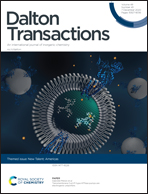Inorganic clusters as metalloligands: ligand effects on the synthesis and properties of ternary nanopropeller clusters†
Abstract
Redox-active multimetallic platforms with synthetically addressable and hemilabile active sites are attractive synthetic targets for mimicking the reactivity of enzymatic co-factors toward multielectron transformations. To this end, a family of ternary clusters featuring three edge metal sites anchored on a [Co6Se8] multimetallic support via amidophosphine ligands are a promising platform. In this report, we explore how small changes in the stereoelectronic properties of these ligands alter [Co6Se8] metalloligand formation, but also substrate binding affinity and strength of the edge/support interaction in two new ternary clusters, M3Co6Se8L6 (M = Zn, Fe; L(−) = Ph2PN(−)iPr). These clusters are characterized extensively using a range of methods, including single crystal X-ray diffraction, electronic absorption spectroscopy and cyclic voltammetry. Substrate binding studies reveal that Fe3Co6Se8L6 resists coordination of larger ligands like pyridine or tetrahydrofuran, but binds the smaller ligand CNtBu. Additionally, investigations into the synthesis of new [Co6Se8] metalloligands using two aminophosphines, Ph2PN(H)iPr (LH) and iPr2PN(H)iPr, led to the synthesis and characterization of Co6Se8LH6, as well as the smaller clusters Co4Se2(CO)6LH4, Co3Se(μ2-PPh2)(CO)4LH3, and [Co(CO)3(iPr2PN(H)iPr)]2. Cumulatively, this study expands our understanding on the effect of the stereoelectronic properties of aminophosphine ligands in the synthesis of cobalt chalcogenide clusters, and, importantly on modulating the push–pull dynamic between the [Co6Se8] support, the edge metals and incoming coordinating ligands in ternary M3Co6Se8L6 clusters.

- This article is part of the themed collection: New Talent: Americas


 Please wait while we load your content...
Please wait while we load your content...